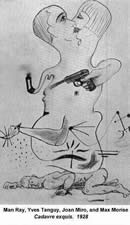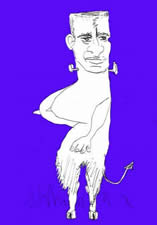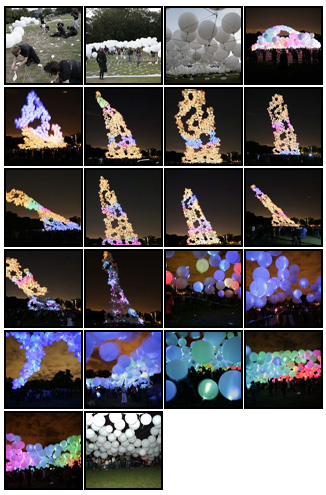From the Exquisite Corpse to the Exquisite and Emergent Corpse
Exquisite Corpse (from the French cadavre exquis)
“A game of folded paper in which a sentence or a drawing is composed by several players, each unaware of the preceding collaboration or collaborations. The now classic example, which gives the game its name, is one of the first sentences which was produced in this way “the exquisite/corpse/will drink/the new/wine.” (André Breton, Dictionnaire abrégé du surréalisme) [1]
The creative method known as the Exquisite Corpse was invented by the Surrealists Marcel Duhamel, Jacques Prévert and Yves Tanguy in 1925.
The game has its origin in the parlour game “consequences” in which players take turns to write on a sheet of paper, doubling it so that what they have written cannot be seen, then passing it on to the next player to add their contribution. In a similar fashion, the Exquisite Corpse is played by a group of people who write or draw a composition in sequence. Each participant can only see the very last part, letter or word of what the previous player has written or drawn. This acts as a register or a new starting point for the person about to draw or write.
In the case of writing, a grammatical structure is decided beforehand, for example: “The adjective noun adverb verb the adjective noun.” However, nothing is decided beforehand regarding theme. Early examples of sentences written by the Surrealists using this technique include:
“The dormitory of friable little girls puts the odious box right.
The Senegal oyster will eat the tricolour bread.” [2]
“The completely black light lays down day and night the powerless suspension to do any good.
The anaemic young girl got the waxed mannequins turned red.
Monsieur Poincaré, if you want, kisses on the mouth, with a peacock feather, in an ardour I never saw before, the late Monsieur de Borniol.
The made-up shrimp hardly enlightens some double kisses.
Rue Mouffetard, love-shivering, amuses the chimera who shoots at us.
The very moved Pathos, thanks singing the bullet of chopped vetiver between Line and Prâline.
Caraco is a beautiful whore: lazy as a doormouse and glass-gloved for doing nothing, she strings pearls with the turkeys of the farce.” [3]
The technique was adapted to drawing by this Surrealist group. [4]
Inspiration for developing the Exquisite Corpse as a drawing or collage technique perhaps came from popular interactive children’s books, whose full-page illustrations of people or animals were horizontally divided into three hinged parts. The first part included the head, the second the torso, and the last, the legs. This design enabled the child to flick through and select from a range of body parts and thus compose fantastical hybrid creatures.
The following examples [4] of drawings were realised in 1927 by André Breton, Goemans Camille, Jacques Prévert and Yves Tanguy:
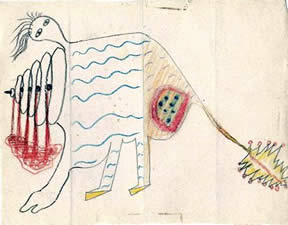
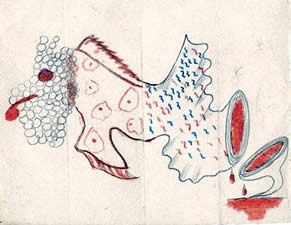
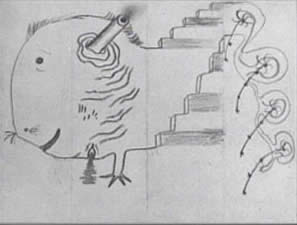
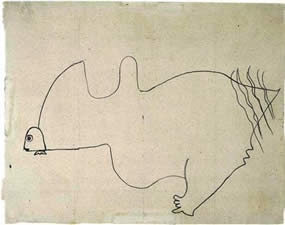
The following drawing was produced by Man Ray, Yves Tanguy, Juan Miro and Max Morise in 1928 [5]:
In these cases, it is clear that the contributors evidently came to a vague agreement beforehand on the general theme.
This is how the game has continued to be played until now. The monster theme in the example below, created in 2005, was surely also decided at the outset [6]:
In publications of the late 1920s, Robert Desnos, Paul Eluard, André Breton and Tristan Tzara, as well as some other critics and artists, argued that creative practice, especially poetic works, ought to be anonymous, collective, intuitive, spontaneous, playful and as automatic as possible.
The poet Nicolas Calas sustained that the use of techniques like the Exquisite Corpse laid bare the “unconscious reality in the personality of the group,” [2] that is to say, the non-verbal psychological character of the anxieties, fears and desires of its members in relation to the affective dynamics taking place within it.
Max Ernst called the process “a mental contagion” [7] He believed the Exquisite Corpse, analysed after the event as a completed work, could tell us much about the creative and intellectual kinship of the group which created it. To my mind, this would imply that the latent cognitive processes of concept formation and knowledge development such creative collaborations involve are examples of emergent behaviour.
Across Art Forms
A modified version of Exquisite Corpse technique was applied to novel writing by the members of the Detective Club [8] in 1931. Fourteen authors, in this case having read the content of previous chapters, wrote a murder story, The Floating Admiral. They wrote each chapter sequentially as individuals and without direction. Each writer also wrote their solution to the murder mystery and placed this in a sealed envelope. The envelopes were not opened until completion of the final chapter’s denouement by Anthony Berkeley. All the other authors’ solutions were included in the final publication as appendices.
Composers Virgil Thomson, John Cage, Henry Cowell and Lou Harrison often collaborated on Exquisite Corpse musical pieces in the mid 1940s. As Don Gillespie, a colleague of Lou Harrison explains [9]:
“One composer would write a bar of music, and the next, without seeing that measure, would continue with another measure, and so on until the piece ended. From the surviving sketches that Lou (Harrison) saved, Robert Hughes had arranged twenty of these pieces for flute, clarinet, bassoon, horn, and piano.” [10]
“For a cover, the designer Pamela Tucker (in 1982) had the idea of asking the three still living composers (Virgil, John, and Lou) to use the same game procedure for the publication’s cover drawing and for its end-piece.” [10]
Two collections of dark and mysterious short stories, Exquis Cadavres, published by radio presenter Brigitte Kernel in 2001 and 2002 [11], were written by her and listeners during a radio program, Noctiluque on the France Inter channel.
The 1984 movie Anijam directed by Marv Newland, which follows the adventures of a cartoon character called Foska, features the work of 22 independent and geographically dispersed animators on a filmic Exquisite Corpse. That is to say, each animator received only the last frame of the previous animator’s contribution. They had no further knowledge of the content of previous contributions and did not know where their effort was due to be placed in the final film sequence. [12] [13]
Interactivity and Interaction
In the Exquisite Corpses above, clearly defined and subsequently unchanged contributions were simply added, in linear fashion, to the empty space at the end of the previously completed part of the sequence. This classic technique has become popular on the internet. [14] However, the technique can be adapted to involve a more interactive creative process, where each contribution relates to a number of earlier contributions. The process may involve, for example, the altering of previously submitted work. A more developed collaborative relationship may therefore be established between participants.
Such modified versions of the technique have often been played across conventional postal or email networks and internet forums as a form of mail art, where those involved add to or adapt an existing drawing, collage, textual or musical work. [15]
Photoshop or Layer Tennis [16] [17] is another popular example of such a collaboration which uses the internet, although in this case the process is between only two players and expressly competitive, with the declared winner being the one deemed by a judge to have made the best alterations to the image.
In Mysterious Object at Noon [18] [19], Apichatpong Weerasethakul employed a similar hybrid of the sequential and “additive/subtractive” approach in the making of a film, part documentary and part fiction, about the unrelated lives of people of varied social status living in different parts of Thailand. They were asked to contribute to a story begun by earlier participants. They could say whatever they liked and could even rewind to any point in the story developed so far, in order to change it or simply start their own story from any point they felt more appropriate. The result became the basis for a film script which was then produced as a drama and released in 2000.
Interaction and the Internet: The Exquisite and Emergent Corpse
In Exquisite and Emergent Corpse, a creative event brings real space and communication flows on the internet into the same affective environment. In its use of these technologies it is conspicuously contemporary, since it reflects how the internet and communication technologies have revolutionised how we interact, share information, construct our awareness of the world or simply live and play.
In a more general sense, it seeks to make visually explicit the role of interaction in relation to the influence others have upon us. It emphasises that the multimedia online environment is a mise en scène of collective action. We need only think of the widespread use of blogs, wikis and the scores of online social interaction tools on the internet. [20]
Decisions are made and seen by group members in real time. This is the first major difference from the projects previously introduced. What one or several participants do immediately influences what another does. As interactions occur and participants make these decisions, non-participants can immediately see how the whole picture or story is changing as a result. Patterns of interaction, should they occur, are perceptible.
In order to give further insight into the aims of this project and how its structure reflects them, it might be helpful to compare the Exquisite and Emergent Corpse to another public artwork which, at first glance, seems very similar.
“The Burble is a massive structure reaching up towards the sky, composed of approximately 1000 extra-large helium balloons each of which contains microcontrollers and LEDs that create spectacular patterns of light across the surface of the structure. The public, both audience and performer, come together to control this immense rippling, glowing, bustling ‘Burble’ that sways in the evening sky, in response to movements of the long articulated interactive handle bar at the base of the structure.” [22]
As with the Exquisite and Emergent Corpse, this work is interactive and collaborative, with each individual contributing to the whole. We might assume that participants cannot see the whole work, but only that part near them, at least until the Burble is high in the air.
Burble London, Holland Park, 2007 (photos by Wang Wei) [21]
The movements, caused by the actions of participants imply a conscious choice with regard to determining the movement and form of the Burble.
“The Burble is held down to the ground by the combined weight of the crowds holding on to the handle bar. They may position it as they like. They may curve in on themselves, or pull it in a straight line.” [22]
The patterns of colours echo their movements.
“As people on the ground shake and pump the handle bars of the Burble, they see their movements echoed as colours through the entire system.” [22]
While participants know that movements will change the colour patterns, and they may indeed move in order to effect or see such changes, they themselves do not directly determine the colours or colour combinations. Rather these colour patterns change automatically according to the form which emerges. So, through collective movement, push and pull, they directly influence the form and only indirectly the colour.
An important difference between The Burble and our project is that, in the former, individuals do not control a defined or definable area. Together, participants occupy the perimeter and push and pull on the circumference of the structure. This makes part of the whole rise and fall. However, since the change effected will depend on the cumulative force used by a number of people involved in the push and pull action, the effect on one particular part cannot be clearly assigned to any one individual.
A major aim of our project is to analyse retrospectively the decisions made by each participant. In the Exquisite and Emergent Corpse, the changes each individual makes are both identifiable and the influence they have on others is more subtle. Furthermore, the visualisations and server data collected will enable us to retrace the steps, paths and patterns followed by both individual and groups.
Let’s consider further the advantages of the Exquisite and Emergent Corpse with regard to the stated desire to retrospectively analyse both individual experience and collective behaviour:
-
The range of visibility of each participant is defined. We can also come to understand, even when the Moore Neighbourhoods overlap, the range of possible indirect influences on each individual.
- Participants’ choices are registered. We can, through collected server data, retrace their steps as individuals.
- In the Burble, they choose where to be and may change that location should they wish. They therefore know which part of the whole they are affecting, or at least attempting to affect. In the Exquisite Corpse, their position in the whole is determined randomly by the server. Of course they may log in again, but they still would never know which part of the whole their contribution affects.
- They can retrace their steps. Individuals can return what they control, a fixed square randomly determined by the server, to a previous state. In The Burble, this is not possible, neither in terms of location or content, even if the participant returns to exactly the same place or reverses a previous action.
- The retrospective analysis of the interaction is not complicated by any external flux. Both the Exquisite and Emergent Corpse and the Burble may involve “mental contagion” or unconscious influence. However, in the latter the decision-making of individuals as they are influenced by social interaction or interactivity is not the only factor determining the ever-changing form of the work.
“The form is a combination of the crowd’s desires and the impact of wind currents varying throughout the height of the Burble.” [22]
In assessing the appropriateness of our project with regard to the stated aims of analysing both individual experience and collective behaviour within the broader context of the creative process, we must be certain that we have adequately modified the traditional Exquisite Corpse techniques outlined above.
In the Exquisite and Emergent Corpse, the area each participant controls is set at one coloured square, a very small and simple portion of a greater whole. In the sense that each person’s contribution is partial, it resembles the traditional Exquisite Corpse technique, even if the number of participants is greater and the whole much more expansive.
But here a participant’s actions represent a direct aesthetic response to the decisions made and being made by others. We have therefore modified this technique so that it focuses on the creativity in the interaction.
There are interactions occurring between members of the same Moore Neighbourhood. However, there are many such neighbourhoods, and as explained, influences between them can occur through intermediaries. Influences can therefore be intra-group and inter-group, reflecting the real contemporary social world. Since all data will be collected as data in the server, this may make it possible to make perceptible both these types of influence on the individual.
This should not only help us with the post-event philosophical analysis of individual experience, sensation and perception, but also provide data for statistical analysis of collective behaviour.
From a Physics of Complex Systems perspective, we need participants’ behaviours to be not just observable but numerically quantified, in order to discern patterns of group behaviour, pockets of consensus and evidence of “mental contagion” or Collective Intelligence. Since we have defined certain parameters, such as the numbers in each group and will have ready access to the server data mentioned above, this should be possible.
[1] Dictionnaire Abrége Du Surréalisme, 1938 (with Paul Éluard) – Abridged Dictionary of Surrealism, reprinted in Bonnet, Marguerite, ed. (1988). Oeuvres complètes, 1:328. Paris: Éditions Gallimard.
[2] 2 examples from Dada & Surrealist Art by William S. Rubin, Chief Curator of the Painting and Sculpture Collection, The Museum of Modern Art, New York. Publisher: Harry N. Abrams, Inc., New York 1968.
[3] 7 examples from André Breton’s contribution to the catalogue of an exhibition at La Dragonne, Galerie Nina Dausset, Paris, 7-30 October 1948, entitled “Le Cadavre Exquis: Son Exaltation”, p.5-7, 9-11.1
[4] As explained in André Breton’s contribution to the catalogue of an exhibition at La Dragonne, Galerie Nina Dausset, Paris, 7-30 October 1948, entitled “Le Cadavre Exquis: Son Exaltation”, p.5-7, 9-11.1
[4] La Révolution surréaliste, Issues 9 and 10 (October 1927)
[5] Le Surréalisme en 1929, Variété, (fig. 288 )
[6] A drawing made by two adults and a child taken from Tom Turley’s flickr page: http://flickr.com/photos/t_squared/24802090/
[7] Alastair Brotchie, Surrealist Games, Redstone Press, Routledge, 1978.
[8] The members of the Detective Club who each contributed a chapter were: G.K. Chesterton (who wrote the first chapter), V.L. Whitechurch, G.D.H. Cole, Margaret Cole, Henry Wade, Agatha Christie, John Rode, Milward Kennedy, Freeman Wills Crofts, Edgar Jepson, Clemence Dane and Anthony Berkeley. The last contributed the denouement.
[9] Don Gillespie, Another View on Lou: Lou Harrison—A Personal Publishing Memoir, NewMusicBox, March 1, 2003.
http://www.newmusicbox.org/page.nmbx?id=47vw03
[10] The collection with illustrated cover was called Party Pieces and published in 1982, by the Henmar Press.
http://www.johncage.info/workscage/partypieces.html
[11] Brigitte Kernel, Exquis cadavres, J’ai lu, April 18th, 2001 and Exquis cadavres, tome 2, J’ai lu, June 12th 2002.
[12] Anijam, Animation, 10 min., Canada, 1984.
[13] Another film using an Exquisite Corpse technique, this time involving 12 writers and directors, is the Quebecois film “Cadavre Exquis première edition,” released in 2006 at the Montreal Film Festival. In this case, the general setting for the film, the life of a glam-rock star fallen on hard times who has just made a pact with the devil, was decided beforehand.
[14] Classic examples on the internet
Drawing: http://www.freakmachine.co.uk/home.asp
Digital image creation versions:
http://www.nubiumgraphik.com/cadavres_exquis/
http://www.anexquisitecorpse.net/
A comic: http://www.inedispirou.net/forum/850-millions-dans-la-neige-cadavre-exquis-bd-vt209.html
[15] Downloadable examples can be found at:
Music:
http://exquisite.olseth.org/about.php
http://www.xiphoidprocess.com/ec4/
http://www.fountain-city.com/ec6/
Poetry:
http://bigredpaul.livejournal.com/tag/exquisite+corpse
Story-telling:
http://www.deliciousdemon.com/addaline/index.php
http://www2.csusm.edu/fossilmedia/mobius_project/mobius_project.html
[16] Photoshop Tennis, now called Layer Tennis originated in internet forums in the late 1990’s and early 2000’s. The game was made popular by art director designer Jim Coudal in 2001:
http://www.wired.com/culture/lifestyle/news/2001/09/47132
[17] Layer tennis: http://layertennis.com/
[18] Mysterious Object At Noon, Documentary, 35mm, B&W, 1H 23, Thai w/ English Subtitles, 1: 1.85, Dolby SR, Thailand, 2000.
[19] Official website:
http://www.kickthemachine.com/works/misterios_object_at_noon.html
[20] With regard to online social interaction tools, there are some which relate more clearly to the aims of this project and which may merit further research. One such is LUNARR, which seeks to link people according to correspondences in ever-changing aesthetic judgements: http://elements.lunarr.com/
[22] Open Burble: http://www.haque.co.uk/openburble.php
[23] Burble London: http://www.haque.co.uk/burblelondon.php
Further good examples of traditional Exquisite Corpses in drawing can be found at: http://www.exquisitecorpse.com/
The following publication is eagerly awaited: The Exquisite Corpse: Collaboration, Creativity, and the World’s Most Popular Parlor Game, Eds. Kanta Kochhar-Lindgren, Davis Schneiderman, and Tom Denlinger, University of Nebraska Press (to be published in Autumn 2009).
